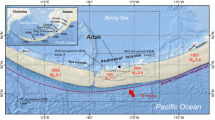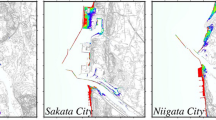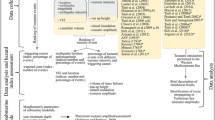Abstract
NAMIDANCE tsunami simulation and visualization tool is used to create tsunami inundation maps showing quantitative maximum tsunami flow depths in Fethiye. The risk of an extreme, but likely earthquake-generated tsunami is estimated at Fethiye Bay for 14 probabilistic earthquake scenarios. The bay is located 36°39′5″N 29°7′23″E, southwestern Turkey, which has coastline to the eastern Mediterranean Sea. The tsunami simulation and inundation assessment are performed in three stages: (1) formation of a digital elevation model of the region from the best available topography/bathymetry dataset, (2) estimation of a maximum credible tsunami scenario for the region and determination of related earthquake parameters, (3) high resolution tsunami simulation and computation of near shore and overland tsunami dynamics in the study area using tsunami simulation and visualization code NAMIDANCE, (4) determination of spatial distributions of tsunami characteristics (maximum water elevations, water velocities, flow depths) under the critical tsunami condition. The results are based on the most recent descriptions of potential tsunami sources, topographic and bathymetric databases, and tsunami numerical models. We present an innovative study concentrating on preparation of quantitative flow depths and inundation maps with a very high-resolution bathymetry/topographic dataset in the eastern Mediterranean. Inundation maps will be used to analyze the effects of possible tsunamis. The presented research is crucial to raising the awareness of government officials, the public, and other stake holders about the high probability of a tsunami event in Turkey. Moreover, the results of this study will help to plan for evacuation routes, establish safe zones, and assist in preparation for the tsunami, creating public awareness, and planning evacuation routes before the actual tsunami event happens.





Similar content being viewed by others
Notes
Galanopoulos (1960), Ambraseys (1962), Antonopoulos (1979), Papadopoulos and Chalkis (1984), Soloviev (1990), Papazachos (1990), Amiran et al. (1994), Cita and Rimoldi (1997), Tinti and Maramai (1996), Cita et al. (1996), Guidoboni and Comastri (1997), Soloviev et al. (2000), McCoy and Heiken (2000), Minoura et al. (2000), Rebesco et al. (2000), Altinok et al. (2001), Dawson et al. (2003), Salamon et al. (2007) and Yolsal et al. (2007).
Foundation for Research and Technology Hellas (FORTH), National Observatory of Athens Institute of Geodynamics (NOAGI), and Middle East Technical University Ocean Engineering Research Center (METU-OERC).
References
Altinok Y., Ersoy S., Yalciner A. C., Alpar B. and Kuran U. (2001), Historical Tsunamis in the Sea of Marmara. International Tsunami Symposium, Session 4, pp. 4–2.
Altinok Y., Alpar B. Ozer N, Aykurt H. (2011), Revision of Tsunami Catalogue Affecting Turkish Coasts and Surrounding Regions, Natural Hazards Earth Syst. Sci., 11, pp. 273–291.
Ambraseys N. N, (1962), Data for the Investigation of Seismic Sea Waves in the Eastern Mediterranean, Bull., Seism., Soc., Am., 52, pp. 895–913.
Amiran, D.H.K., Arieh, E. & Turcotte, T. (1994), Earthquakes in Israel and Adjacent Areas: Macroseismic Observations since 100 B.C.E., Israel Exploration Journal, 44, 260–305.
Antonopoulos, J. (1979) Catalogue of tsunamis in the eastern Mediterranean from antiquity to present times. Annali Di Geofisica, Vol. 32, p. 113–130.
Briggs M., Synolakis C., Harkins G., Green D. (1995), Laboratory Experiments of Tsunami Run-up on Circular Island., Pure and Applied Geophysics, 144 (3/4), pp. 569–563.
B. H. Choi, E. Pelinovsky, K.O. Kim, and J.S. Lee (2003), Simulation of the Trans-oceanic Tsunami Propagation due to the 1883 Krakatau Volcanic Eruption, Natural Hazards and Earth Sciences, 3, pp. 321–332.
Choi, Hong, Hwang., Hidayat, Kaistrenko, Korolev, Kurkin, Pelinovsky,Yalciner, (2005), Catastrophic tsunami in the Indian Ocean (December 26, 2004): data of two field surveys and numerical simulation. Sumatra Tsunami on 26 December 2004, Conference on Sumatra Tsunami on Dec. 26, 2004, Special Asia Tsunami Session, 2, pp. 159–188.
Cita M. B., Camerlenghi A. and RImoldi B., (1996), Deep-sea Tsunami Deposits in the Eastern Mediterraneasn: New Evidence and Depositional Models, Sediment. Geol. 104, 155–173.
Cita M. B., Rimoldi. B. (1997), Geological and Geophysical Evidence for a Holocene Tsunami Deposit in the Eastern Mediterranean Deep-Sea Record, Journal of Geodynamics, 24 (1), pp. 293–304. doi:10.1016/S0264-3707(96)00030-0.
Dawson A. G., Lockett P., Shi S., (2003), Tsunami Hazards in Europe, Environmental International, 30, pp. 577–585.
Dilmen, (2009), GIS Based Tsunami Inundation Maps: Case Studies from Mediterranean, Master Thesis, Middle East Technical University.
Galanopoulos A., (1960), Tsunamis Observed on the Coasts of Greece from Antiquity to Present Time. Annali di Geofisica, 13, pp. 369–386.
Goto, C. and Ogawa, Y., (1991), Numerical Method of Tsunami Simulation With the Leap-Frog Scheme, Translated for the TIME Project by Prof. Shuto, N., Disaster Control Res. Cent., Faculty of Eng., Tohoku Univ. Sendai, Japan.
Guidoboni E. and Comastri A., (1997). The large Earthquake of 8 August 1303 in Crete: Seismic Scenario and Tsunami in the Mediterranean Area. Journal of Seismology, 1, 55–72
Imamura F., (1989), Tsunami Numerical Simulation with the Staggered Leap-frog Scheme, School of Civil Engineering, Asian Inst. Tech. and Disaster Control Research Center, Tohoku University.
Kânoglu, U. (2004): Nonlinear evolution and runup-rundown of long waves over a sloping beach. J. Fluid Mech., 513, 363–372.
Kânoglu, U., Titov. V., Aydın B., Moore C., Stefanakis S. T., Zhou H., Spillane M., Synolakis C. E., (2013): Focusing of long waves with finite crest over constant depth Proc. R. Soc. A. 2013 469 2153 20130015; doi:10.1098/rspa.2013.0015 (published 27 February 2013) 1471–2946.
Kurkin A.A., Kozelkov A.C., Zaitsev A.I., Zahibo N., and Yalciner A., (2003), Tsunami risk for the Caribbean Sea Coast. Izvestiya, Russian Academy of Engineering Sciences, 4, pp. 126–149.
MaramaiS., A. and Graziani, L., (2004), The New Catalogue of Italian Tsunamis, Natural Hazards, Vol. 33, No. 3, pp. 439–465.
McCoy, F. W. and Heiken, G., (2000), Tsunami Generated by the Late Bronze Age Eruption of Thera (Santorini), Greece, Pure and Applied Geophysics, v.157:1227–1256.
Minoura K., Imamura F., Kuran U., Nakamura T., Papadopolous G., Takahashi T., Yalciner A. C., (2000), Discovery of Minoan Tsunami Deposits, Geology, V. 28, No. 1, pp. 59–62.
Ocakoglu, (2012), Investigation of Fethiye-Marmaris Bay (SW Anatolia): seismic and morphologic evidences from the missing link between the Pliny Trench and the Fethiye-Burdur Fault Zone, Geomarine Letters, 32:17–28 doi:10.1007/s00367-011-0234-2.
Okal E. and Synolakis (2004), Source discriminants for near-field tsunamis, Geophys. J. Int. 158, 899–912, doi:10.1111/j.1365-246X.2004.02347.X
Papadopoulos G. A., (2009) Tsunamis. In: the Physical Geography of Mediterranean, by J.C. Woodward (ed.), Oxford Univ. Press, Oxford, p.493–512.
Papadopoulos G. A. and Chalkis, B. J., (1984), Tsunamis observed in Greece and the surrounding area from antiquity to the present times, Marine Geol. 56, pp. 309–317 (footnote 1).
Papazachos B. C. (1990), Seismicity of the Aegean and Surrounding Area, Tectonophysics, 178, 27–308
Rebesco M. B., Vedova B., Cernobori L., Aloisi A. (2000), Acoustic Facies of Halocene Megaturbidites in the Eastern Mediterranean, Sediment. Geol., 135, 65–74.
Salamon A., Rockwell T., Ward S. N., Guidoboni E., and Comastri A., (2007), Tsunami Hazard Evaluation of the Eastern Mediterranean: Historical Analysis and Selected Modeling, Bulletin of Seismological Society of America, 97, 705–724.
Soloviev, S., Solovieva O. N, Chan N. G., Khen S. K., Shcetnikov N. A. (2000), Tsunamis in the Mediterranean Sea: 2000 B.C. - 2000 A.D. Translation from Russian to English by Gil B. Pontecorvo and Vasiiy I- Tropin; Kluwer Academic Publishers, Dordrecht, The Netherlands, 2000, 237.
Soloviev, S.L. (1990), Tsunamigenic Zones in the Mediterranean Sea. Natural Hazards, Vol. 3, 1990, pp 183–202.
Tinti S. and Maramai, A. (1996), Catalogue of Tsunamis Generated in Italy and in Côte d’ Azur, France: A Step towards a Unified Catalogue of Tsunamis in Europe, Annali di Geofisica, 39, pp. 1253–1299.
Yalciner A. C. Alpar B., Altinok Y., Ozbay I., Imamura F., (2002), Tsunamis in the Sea of Marmara: Historical Documents for the Past, Models for Future Marine Geology, 2002, 190, pp. 445–463.
Yalciner, A., Pelinovsky, E., Talipova, T., Kurkin, A., Kozelkov, A. and Zaitsev, A., (2004), Tsunamis in the Black Sea: Comparison of the Historical, Instrumental, and Numerical Data, J. Geophys. Res., AGU, V 109, C12023, doi:10.1029/2003JC002113.
Yalciner, A.C., Karakus, H. and Kuran, U (2006), Modeling of Tsunamis in the Eastern Mediterranean and Comparison with Caribbean, Caribbean Tsunami Hazard, World Scientific, ISBN: 981-256-535-3, 326–340.
Yalciner, A. C., Pelinovsky, E., Zaitsev, A., Kurkin, A., Ozer, C., and Karakus, H., (2007a), Modeling and visualization of tsunamis: Mediterranean examples, from, Tsunami and Nonlinear Waves (Ed: Anjan Kundu), Springer, 2007, pp. 2731–2839.
Yalciner A., Pelinovsky E., ZAytsev A., Ozer C., Kurkin A., Karakus H., Ozyurt G., (2007b), Modeling and visualization of tsunamis: Mediterranean examples, in book: Tsunami and Nonlinear Waves Kundu Anjan, Springer, pp. 273–283.
Yalciner A. C., Suppasri A., Mas E., Kalligeris N., Necmioglu O., Imamura F., Ozer C., Zaytsev A., Ozel M. N., Synolakis C., (2011), Field Survey on the Coastal Impacts of March 11, 2011 Great East Japan Tsunami, Submitted to Journal of Pure and Applied Geophysics, (in review).
Yolsal, S., Taymaz, T. and Yalciner, A.C., (2007), Understanding tsunamis, potential source regions and tsunami-prone mechanisms in the Eastern Mediterranean Geological Society, London, Special Publications, 291, pp. 201–230.
Zahibo, N., Pelinovsky, E., Yalciner, A., Kurkin, A., Koselkov, A., and Zaitsev, A. (2003), The 1867 Virgin Island Tsunami: Observations and Modelling. Oceanologica Acta, 26, pp. 609–621.
Acknowledgments
This study is partly supported by TRANSFER and SEAHELLARC Projects granted by European Commission, UDAP-Ç-12-14 project granted by Disaster Emergency Management Presidency of Turkey (AFAD), and 108Y227 project by TUBITAK and DPT 2011K140210 Projects.
Author information
Authors and Affiliations
Corresponding author
Rights and permissions
About this article
Cite this article
Dilmen, D.I., Kemec, S., Yalciner, A.C. et al. Development of a Tsunami Inundation Map in Detecting Tsunami Risk in Gulf of Fethiye, Turkey. Pure Appl. Geophys. 172, 921–929 (2015). https://doi.org/10.1007/s00024-014-0936-2
Received:
Revised:
Accepted:
Published:
Issue Date:
DOI: https://doi.org/10.1007/s00024-014-0936-2




